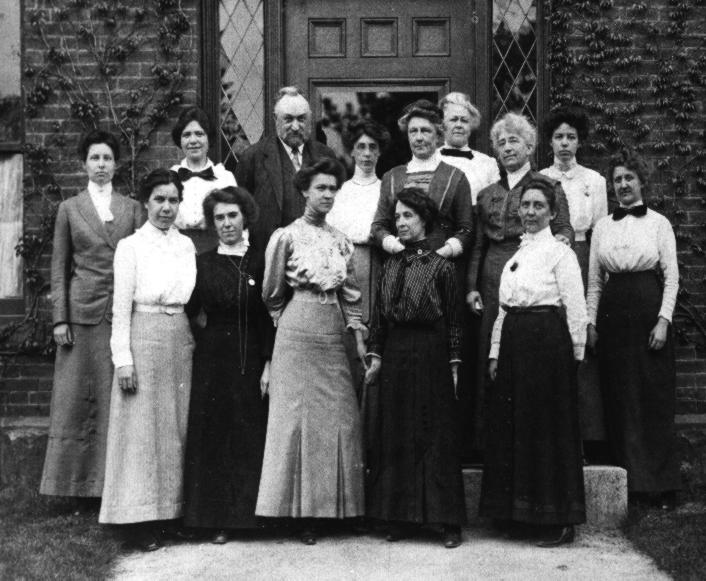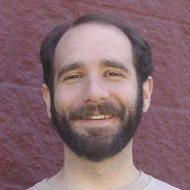“Oh, Be A Fine Girl, Kiss Me”
—Traditional mnemonic for stellar classification

Pickering's "Harem." Back row (L to R): Margaret Harwood (far left), Mollie O'Reilly, Edward C. Pickering, Edith Gill, Annie Jump Cannon, Evelyn Leland (behind Cannon), Florence Cushman, Marion Whyte (behind Cushman), Grace Brooks.
Front row: Arville Walker, unknown (possibly Johanna Mackie), Alta Carpenter, Mabel Gill, Ida Woods.
On Cosmos last Sunday, Neil deGrasse Tyson explored the lifecycle of stars, and how atoms formed in stars go on to produce everything we can see and touch. He also, at last, dug into the vital role of women in the development of science.
For better or worse, the show didn’t cover Caroline Herschel, who cataloged the stars and discovered comets and may be the first woman in world history to earn a public salary to practice science (and whose brother and nephew have both been profiled in past episodes), but it prominently featured Annie Jump Cannon and Cecilia Payne (later Payne-Gaposchkin). These women worked at Harvard at the turn of the 20th century. Cannon was part of a team that cataloged the observable stars, and she developed the classification of stars based on their spectra that is still used today. (She may have created the mnemonic above as well.)
Like Caroline Herschel over a century earlier, Cannon and the rest of what was known as Pickering’s Harem were responsible for cataloging the observations made by male astronomers.
Payne realized that the categories Cannon had discovered could be explained by differences in stellar temperature. This led to new discoveries about the composition of stars, and a realization about what happens when stars die. The conclusion that anything outside of a star that isn’t hydrogen or helium must have started out inside a star, a result of eons of fusion (and the crushing force of a supernova in the case of heavier elements) was groundbreaking. As Tyson says, Cannon and Payne’s work “made it possible for us to read the life stories of the stars, and to trace the story of life itself back to its beginnings in their fiery deaths.”
That prospect of a scientific, natural explanation of the birth of stars, life, and everything else troubles creationists. At the Discovery Institute’s blog, Casey Luskin (a lawyer who serves as the Disco. ‘tute’s “Research Director”) objects, wondering, “Cosmos Says We’re Made of ‘Stardust’; But Is That All?”
He [Tyson] went on to say that all of our elements, our society, everything about us is “stardust.” He explained, “We are made by the atoms and the stars” and “our matter and our form are forged by the great and ancient cosmos of which we are a part.” But is that the end of the story, as Tyson makes it sound? Is our “form” forged by the cosmos alone?
The answer, at least as far as science goes, is “yes,” and Luskin presents no particular evidence to doubt that conclusion, just hand-waving about the possibility that the cosmos was fine-tuned to allow human existence. As Tyson points out in discussing the constellations, humans have always imposed their own stories on the stars (and on the gaps in the Milky Way caused by interstellar dust clouds). We place our heroes in the skies above us, along with familiar animals and tools. Luskin’s approach is built from that same mold. Scientific observations force us to be objective, though, to see stars for what they are, not for what we might wish they are. That means seeing ourselves for what we are as well.
And that’s a beautiful prospect. An emu-shaped hole in the sky or a passel of fleeing maidens is nice, but there’s something even more wondrous in the images that the Hubble telescope gives us of the reality of deep space, and the staggering realization that struck Cecilia Payne when she saw that the elements on Earth are not the same as those in the stars, but are in fact the descendants of the atoms in stars. As Tyson put it: “We are made by the atoms and the stars. Our matter and our form are forged by the great and ancient cosmos, of which we are a part.”
There’s a grandeur in this view of life. Instead of elevating ourselves by placing bits of our terrestrial experience into the sky, we know that they started out in the sky, and the entangled bank Darwin wrote about is rooted in the death throes of stars.

